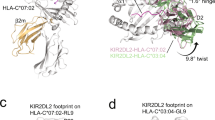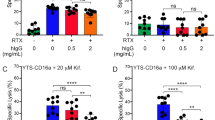Abstract
Using flow cytometry, fluorescent microscopy and examination of receptor glycosylation status, we demonstrate that an entire killer cell immunoglobulin-like receptor (KIR) locus (KIR2DS3)—assumed earlier to be surface expressed—appears to have little appreciable surface expression in transfected cells. This phenotype was noted for receptors encoded by three allelic variants including the common KIR2DS3*001 allele. Comparing the surface expression of KIR2DS3 with that of the better-studied KIR2DS1 molecule in two different cell lines, mutational analysis identified multiple polymorphic amino-acid residues that significantly alter the proportion of molecules present on the cell surface. A simultaneous substitution of five residues localized to the leader peptide (residues −18 and −7), second domain (residues 123 and 150) and transmembrane region (residue 234) was required to restore KIR2DS3 to the expression level of KIR2DS1. Corresponding simultaneous substitutions of KIR2DS1 to the KIR2DS3 residues resulted in a dramatically decreased surface expression. Molecular modeling was used to predict how these substitutions contribute to this phenotype. Alterations in receptor surface expression are likely to affect the balance of immune cell signaling impacting the characteristics of the response to pathogens or malignancy.
This is a preview of subscription content, access via your institution
Access options
Subscribe to this journal
Receive 6 digital issues and online access to articles
$119.00 per year
only $19.83 per issue
Buy this article
- Purchase on Springer Link
- Instant access to full article PDF
Prices may be subject to local taxes which are calculated during checkout







Similar content being viewed by others
References
Lanier LL . NK cell recognition. Annu Rev Immunol 2005; 23: 225–274.
Hsu KC, Chida S, Dupont B, Geraghty DE . The killer cell immunoglobulin-like receptor (KIR) genomic region: gene-order, haplotypes and allelic polymorphism. Immunol Rev 2002; 190: 40–52.
Rajagopalan S, Long EO . Understanding how combinations of HLA and KIR genes influence disease. J Exp Med 2005; 201: 1025–1029.
Stewart CA, Laugier-Anfossi F, Vely F, Saulquin X, Riedmuller J, Tisserant A et al. Recognition of peptide–MHC class I complexes by activating killer immunoglobulin-like receptors. Proc Natl Acad Sci USA 2005; 102: 13224–13229.
Katz G, Markel G, Mizrahi S, Arnon TI, Mandelboim O . Recognition of HLA-Cw4 but not HLA-Cw6 by the NK cell receptor killer cell Ig-like receptor two-domain short tail number 4. J Immunol 2001; 166: 7260–7267.
Winter CC, Gumperz JE, Parham P, Long EO, Wagtmann N . Direct binding and functional transfer of NK cell inhibitory receptors reveal novel patterns of HLA-C allotype recognition. J Immunol 1998; 161: 571–577.
Saulquin X, Gastinel LN, Vivier E . Crystal structure of the human natural killer cell activating receptor KIR2DS2 (CD158j). J Exp Med 2003; 197: 933–938.
Katz G, Gazit R, Arnon TI, Gonen-Gross T, Tarcic G, Markel G et al. MHC class I-independent recognition of NK-activating receptor KIR2DS4. J Immunol 2004; 173: 1819–1825.
Biassoni R, Pessino A, Malaspina A, Cantoni C, Bottino C, Sivori S et al. Role of amino acid position 70 in the binding affinity of p50.1 and p58.1 receptors for HLA-Cw4 molecules. Eur J Immunol 1997; 27: 3095–3099.
Carr WH, Rosen DB, Arase H, Nixon DF, Michaelsson J, Lanier LL . Cutting Edge: KIR3DS1, a gene implicated in resistance to progression to AIDS, encodes a DAP12-associated receptor expressed on NK cells that triggers NK cell activation. J Immunol 2007; 178: 647–651.
Pando MJ, Gardiner CM, Gleimer M, McQueen KL, Parham P . The protein made from a common allele of KIR3DL1 (3DL1*004) is poorly expressed at cell surfaces due to substitution at positions 86 in Ig domain 0 and 182 in Ig domain 1. J Immunol 2003; 171: 6640–6649.
VandenBussche CJ, Dakshanamurthy S, Posch PE, Hurley CK . A single polymorphism disrupts the killer Ig-like receptor 2DL2/2DL3 D1 domain. J Immunol 2006; 177: 5347–5357.
Winter CC, Long EO . A single amino acid in the p58 killer cell inhibitory receptor controls the ability of natural killer cells to discriminate between the two groups of HLA-C allotypes. J Immunol 1997; 158: 4026–4028.
Yawata M, Yawata N, Draghi M, Little AM, Partheniou F, Parham P . Roles for HLA and KIR polymorphisms in natural killer cell repertoire selection and modulation of effector function. J Exp Med 2006; 203: 633–645.
Gardiner CM, Guethlein LA, Shilling HG, Pando M, Carr WH, Rajalingam R et al. Different NK cell surface phenotypes defined by the DX9 antibody are due to KIR3DL1 gene polymorphism. J Immunol 2001; 166: 2992–3001.
Martin MP, Qi Y, Gao X, Yamada E, Martin JN, Pereyra F et al. Innate partnership of HLA-B and KIR3DL1 subtypes against HIV-1. Nat Genet 2007; 39: 733–740.
Lanier LL, Corliss BC, Wu J, Leong C, Phillips JH . Immunoreceptor DAP12 bearing a tyrosine-based activation motif is involved in activating NK cells. Nature 1998; 391: 703–707.
Campbell KS, Cella M, Carretero M, Lopez-Botet M, Colonna M . Signaling through human killer cell activating receptors triggers tyrosine phosphorylation of an associated protein complex. Eur J Immunol 1998; 28: 599–609.
Snyder MR, Nakajima T, Leibson PJ, Weyand CM, Goronzy JJ . Stimulatory killer Ig-like receptors modulate T cell activation through DAP12-dependent and DAP12-independent mechanisms. J Immunol 2004; 173: 3725–3731.
Robinson J, Waller MJ, Fail SC, Marsh SG . The IMGT/HLA and IPD databases. Hum Mutat 2006; 27: 1192–1199.
Hou L, Steiner NK, Chen M, Belle I, Kubit AL, Ng J et al. Limited allelic diversity of stimulatory two domain killer immunoglobulin-like receptors. Hum Immunol 2008; 69: 174–178.
Steiner NK, Dakshanamurthy S, VandenBussche CJ, Hurley CK . Extracellular domain alterations impact surface expression of stimulatory natural killer cell receptor KIR2DS5. Immunogenetics 2008; 60: 655–667.
Anjos S, Nguyen A, Ounissi-Benkalha H, Tessier MC, Polychronakos C . A common autoimmunity predisposing signal peptide variant of the cytotoxic T-lymphocyte antigen 4 results in inefficient glycosylation of the susceptibility allele. J Biol Chem 2002; 277: 46478–46486.
Fan QR, Mosyak L, Winter CC, Wagtmann N, Long EO, Wiley DC . Structure of the inhibitory receptor for human natural killer cells resembles haematopoietic receptors. Nature 1997; 389: 96–100.
Drescher B, Witte T, Schmidt RE . Glycosylation of FcgammaRIII in N163 as mechanism of regulating receptor affinity. Immunology 2003; 110: 335–340.
Lau KS, Partridge EA, Grigorian A, Silvescu CI, Reinhold VN, Demetriou M et al. Complex N-glycan number and degree of branching cooperate to regulate cell proliferation and differentiation. Cell 2007; 129: 123–134.
Feng J, Call ME, Wucherpfennig KW . The assembly of diverse immune receptors is focused on a polar membrane-embedded interaction site. PLoS Biol 2006; 4: e142.
Chiesa MD, Romeo E, Falco M, Balsamo M, Augugliaro R, Moretta L et al. Evidence that the KIR2DS5 gene codes for a surface receptor triggering natural killer cell function. Eur J Immunol 2008; 38: 2284–2289.
Bontadini A, Testi M, Cuccia MC, Martinetti M, Carcassi C, Chiesa A et al. Distribution of killer cell immunoglobulin-like receptors genes in the Italian Caucasian population. J Transl Med 2006; 4: 44.
Dohring C, Samaridis J, Colonna M . Alternatively spliced forms of human killer inhibitory receptors. Immunogenetics 1996; 44: 227–230.
Pettersen EF, Goddard TD, Huang CC, Couch GS, Greenblatt DM, Meng EC et al. UCSF Chimera--a visualization system for exploratory research and analysis. J Comput Chem 2004; 25: 1605–1612.
Acknowledgements
Funding from the Office of Naval Research N00014-05-1-0784 and N00014-06-1-0726 supported this research. The views expressed in this paper are those of the authors and do not reflect the official policy of the Department of Navy, the Department of Defense or the United States government. These studies were conducted using the Tissue Culture, Flow Cytometry and Cell Sorting, Macromolecular Analysis, and Microscopy and Imaging Shared Resources of Lombardi Comprehensive Cancer Center. Computing time and support were in part provided by the Advanced Biomedical Computing Center at the National Cancer Institute (Frederick, MD, USA). Molecular graphics images were produced using the UCSF Chimera package from the Resource for Biocomputing, Visualization, and Informatics at the University of California, San Francisco. We thank Thanemozhi Govindan, Michelle Makiya and Karen Creswell for providing excellent technical assistance.
Author information
Authors and Affiliations
Corresponding author
Rights and permissions
About this article
Cite this article
VandenBussche, C., Mulrooney, T., Frazier, W. et al. Dramatically reduced surface expression of NK cell receptor KIR2DS3 is attributed to multiple residues throughout the molecule. Genes Immun 10, 162–173 (2009). https://doi.org/10.1038/gene.2008.91
Received:
Revised:
Accepted:
Published:
Issue Date:
DOI: https://doi.org/10.1038/gene.2008.91
Keywords
This article is cited by
-
Association analysis of KIR/HLA genotype with liver cirrhosis, hepatocellular carcinoma, and NUC freedom in chronic hepatitis B patients
Scientific Reports (2021)
-
The role of killer-cell immunoglobulin-like receptor (KIR) genes in susceptibility to inflammatory bowel disease: systematic review and meta-analysis
Inflammation Research (2018)
-
Killer-cell immunoglobulin-like receptor genes and ligands and their role in hematologic malignancies
Cancer Immunology, Immunotherapy (2016)
-
A comprehensive analysis of the binding of anti-KIR antibodies to activating KIRs
Genes & Immunity (2014)
-
Conserved KIR allele-level haplotypes are altered by microvariation in individuals with European ancestry
Genes & Immunity (2012)



